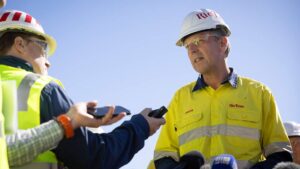Monsters of Rock: Has Rio Tinto cracked this green steel thing with biomass?

Pic: Pipitpan Lerdpipitpon/iStock via Getty Images
- Rio Tinto says it has successfully made steel from Pilbara iron ore by replacing coal with biomass at a small pilot scale
- 66% of Rio’s carbon footprint is not from its own operations but through the steel factories it supplies
- Global steel output flat in October: WSA
Rio Tinto (ASX:RIO) is, like iron ore stable mates BHP (ASX:BHP) and Fortescue Metals Group (ASX:FMG) investing plenty of billions in decarbonisation.
The capex bill will amount to US$7.5 billion this decade, centred on its own operations where the company is hoping to cut scope 1 and 2 emissions in half by 2030.
But that isn’t the biggest challenge.
Emissions from steelmakers buying Rio’s iron ore actually make up 66% of its carbon footprint. With steel mills contributing to 8% of the world’s CO2 emissions, it could be argued that will be the real battlefront.
At the moment most steel is made in the blast furnace, a process which dominates China and India’s steel industries, respectively the largest and fastest growing in the world. It requires metallurgical coal as a reductant to convert iron ore.
According to miners like BHP, there simply isn’t enough scrap steel to convert all steel production currently to the recycling based electric arc furnace process, which if run on renewables is the only “green steel” process theoretically available right now at commercial scale.
The main technology being researched at the moment is green hydrogen to power previously gas-fired direct reduced iron plants, a process with its own issues because it will require extremely high grades of iron ore pellets at production rates five times above current levels.
But Rio may have brought a secret weapon to the fight to green up the steel sector.
BIOMASS
That’s right, its predictably trademarked BioIron process is using something called lignocellulosic biomass instead of coal, things like wheat straw, canola stalks and bagasse leftover from sugar cane processing.
An initial testing phase in a small pilot plant in Germany showed, according to Rio, that the process could convert Pilbara iron ore to metallic iron with just this biomass and renewable powered microwave energy to support “near-zero CO2 steel-making”.
With carbon capture and storage, Rio says, it could result in “net negative emissions”.
For the past year and a half Rio, Metso Outotec and the University of Nottingham’s delectably titled Microwave Process Engineering Group have tested the process with batches consisting of 1000 golf ball sized servings of iron ore and briquettes of the agricultural chaff.
That it could be suited to Pilbara fines is an interesting proposition, and an exciting one potentially for the Pilbara majors.
The hematite iron ore found in the Pilbara, and sold by the hundreds of millions of tonnes into China, Japan, Korea and Taiwan, among other places, each year, is notoriously resistant to beneficiation.
Several attempts to convert it into higher grade ore suited to ‘green steel’ have failed to hit the mark.
“Finding low-carbon solutions for iron and steelmaking is critical for the world as we tackle the challenges of climate change. Proving BioIron works at this scale is an exciting development given the implications it could have for global decarbonisation,” Rio chief commercial officer Alf Barrios said.
“The results from this initial testing phase show great promise and demonstrate that the BioIron process is well suited to Pilbara iron ore fines.
“BioIron is just one of the pathways we are developing in our decarbonisation work with our customers, universities and industry to reduce carbon emissions right across the steel value chain.”
World steel flat in October
It comes as the World Steel Association released figures for October overnight, showing global production remained flat year on year last month at 147.3Mt.
Year to date steel output globally has fallen 3.9% to 1.5527Bt in 2022.
There have been big slides in output in the EU, elsewhere in Europe, North America and, understandably Russia, the former Soviet states and Ukraine.
In Asia meanwhile production rose 5.8% YoY with Chinese production up 11% on last year’s dire October levels, enforced by the Communist Party in a second half of 2021 pollution crackdown.
China, producer of almost 60% of the world’s crude steel, has delivered 860.6Mt in the first 10 months of the year, down 2.2% on the same time in 2021 and on track for a second successive fall in steel output.
The theory goes that Xi’s playground, determined to hit peak emissions by 2030 and net zero by 2060, may have already hit peak steel potentially hurting long term demand for iron ore.
BHP has taken a different tact, with its chief economist Huw McKay telling analysts in a recent tour of its Pilbara operations that steel will be a net beneficiary of decarbonisation.
That will come both due to rising steel demand for renewables, but also ironically because extreme weather conditions will mean equipment will wear and need replacing faster.
Iron ore miners share prices today:
UNLOCK INSIGHTS
Discover the untold stories of emerging ASX stocks.
Daily news and expert analysis, it's free to subscribe.
By proceeding, you confirm you understand that we handle personal information in accordance with our Privacy Policy.








